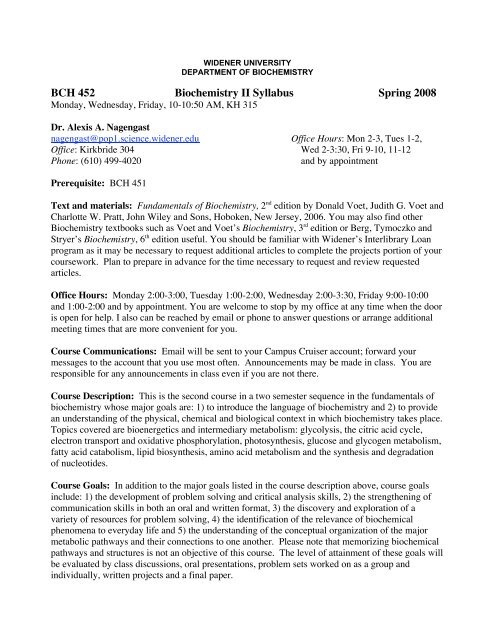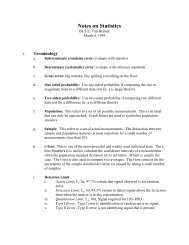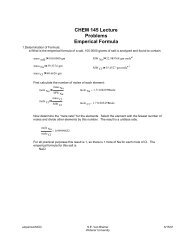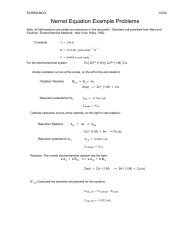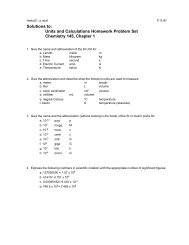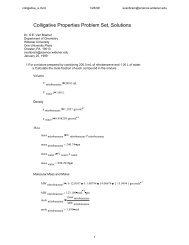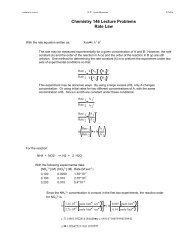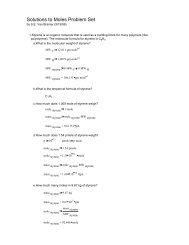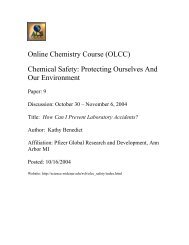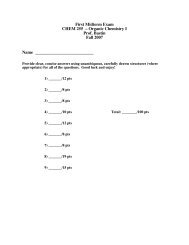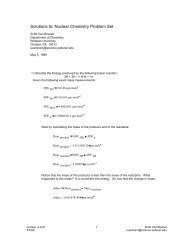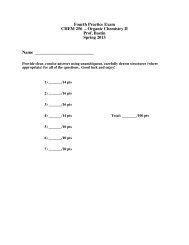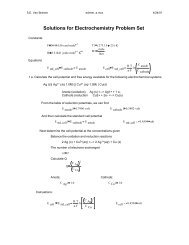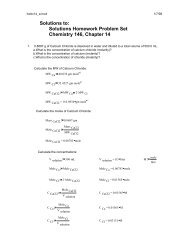BCH 452 Biochemistry II Syllabus Spring 2008 - These Pages Have ...
BCH 452 Biochemistry II Syllabus Spring 2008 - These Pages Have ...
BCH 452 Biochemistry II Syllabus Spring 2008 - These Pages Have ...
Create successful ePaper yourself
Turn your PDF publications into a flip-book with our unique Google optimized e-Paper software.
WIDENER UNIVERSITY<br />
DEPARTMENT OF BIOCHEMISTRY<br />
<strong>BCH</strong> <strong>452</strong> <strong>Biochemistry</strong> <strong>II</strong> <strong>Syllabus</strong> <strong>Spring</strong> <strong>2008</strong><br />
Monday, Wednesday, Friday, 10-10:50 AM, KH 315<br />
Dr. Alexis A. Nagengast<br />
nagengast@pop1.science.widener.edu Office Hours: Mon 2-3, Tues 1-2,<br />
Office: Kirkbride 304 Wed 2-3:30, Fri 9-10, 11-12<br />
Phone: (610) 499-4020 and by appointment<br />
Prerequisite: <strong>BCH</strong> 451<br />
Text and materials: Fundamentals of <strong>Biochemistry</strong>, 2 nd edition by Donald Voet, Judith G. Voet and<br />
Charlotte W. Pratt, John Wiley and Sons, Hoboken, New Jersey, 2006. You may also find other<br />
<strong>Biochemistry</strong> textbooks such as Voet and Voet’s <strong>Biochemistry</strong>, 3 rd edition or Berg, Tymoczko and<br />
Stryer’s <strong>Biochemistry</strong>, 6 th edition useful. You should be familiar with Widener’s Interlibrary Loan<br />
program as it may be necessary to request additional articles to complete the projects portion of your<br />
coursework. Plan to prepare in advance for the time necessary to request and review requested<br />
articles.<br />
Office Hours: Monday 2:00-3:00, Tuesday 1:00-2:00, Wednesday 2:00-3:30, Friday 9:00-10:00<br />
and 1:00-2:00 and by appointment. You are welcome to stop by my office at any time when the door<br />
is open for help. I also can be reached by email or phone to answer questions or arrange additional<br />
meeting times that are more convenient for you.<br />
Course Communications: Email will be sent to your Campus Cruiser account; forward your<br />
messages to the account that you use most often. Announcements may be made in class. You are<br />
responsible for any announcements in class even if you are not there.<br />
Course Description: This is the second course in a two semester sequence in the fundamentals of<br />
biochemistry whose major goals are: 1) to introduce the language of biochemistry and 2) to provide<br />
an understanding of the physical, chemical and biological context in which biochemistry takes place.<br />
Topics covered are bioenergetics and intermediary metabolism: glycolysis, the citric acid cycle,<br />
electron transport and oxidative phosphorylation, photosynthesis, glucose and glycogen metabolism,<br />
fatty acid catabolism, lipid biosynthesis, amino acid metabolism and the synthesis and degradation<br />
of nucleotides.<br />
Course Goals: In addition to the major goals listed in the course description above, course goals<br />
include: 1) the development of problem solving and critical analysis skills, 2) the strengthening of<br />
communication skills in both an oral and written format, 3) the discovery and exploration of a<br />
variety of resources for problem solving, 4) the identification of the relevance of biochemical<br />
phenomena to everyday life and 5) the understanding of the conceptual organization of the major<br />
metabolic pathways and their connections to one another. Please note that memorizing biochemical<br />
pathways and structures is not an objective of this course. The level of attainment of these goals will<br />
be evaluated by class discussions, oral presentations, problem sets worked on as a group and<br />
individually, written projects and a final paper.
Grading: The course will be graded on the +/- system as follows:<br />
Attendance, Preparation, Participation 5%<br />
Problem Sets 35%<br />
Midterm Individual Problem Set 10%<br />
Original Case Study Project Written Report 20%<br />
Original Case Study Class-led Discussion 10%<br />
Newborn Screening Project Paper 10%<br />
Newborn Screening Project Presentation 10%<br />
Attendance, Preparation, Participation: Attendance is required. Whether working as an<br />
individual or in a team, your participation and input are essential to your learning and that of the<br />
class. Initial exposure to the field of metabolism entails a large body of material in the form of<br />
chemical reactions and structures that can be tedious and difficult to learn by simply watching<br />
someone talk about it. Rather than listen to a formal lecture each class period, we will have<br />
interactive discussions about the chapter material and problem sets. The degree of interaction and<br />
effectiveness of class time is dependent on your individual preparation. Therefore, this portion of<br />
your grade is subjectively based on your class performance and participation in the form of<br />
discussions and asking and answering questions.<br />
Problem Sets: There are no formal exams in this class. Instead, problem sets will provide an<br />
assessment of your understanding of the material and they represent the major portion of your grade.<br />
You are expected to be familiar with the chapter material before our initial discussion on Mondays<br />
when Problem Sets will be distributed. Problem sets are typically due each Friday, preferably at the<br />
beginning of class, unless otherwise noted in class. Wednesday and Friday class periods will be<br />
spent working on and discussing the problem set as a team. I encourage teamwork because research<br />
has shown that students working in groups learn more, understand more and remember more.<br />
However, you are to process the group effort by yourself and submit your problem sets individually<br />
with the answers in your own words. Additionally, the Midterm Problem Set is to be completed<br />
individually with no input from other students. Problem Set solutions should be insightful, well<br />
thought-out, clear, organized, neatly written or typed and include structures. After you have given<br />
some initial thought to the problems, you may want to use additional resources besides your<br />
textbook such as the Internet, primary or secondary literature and other students. While Wikipedia<br />
can be used as a starting point, you will get much more out of the problem sets if you research<br />
deeper. Properly cite all of your sources. The preferred format for referencing citations is:<br />
Book<br />
Journal Article<br />
Website<br />
Authors, Title of Book, Edition, Publishing Company, location, date of<br />
publication, pages used.<br />
Authors, (Date) Title of Article. Journal Title Vol (No): pages.<br />
Title of webpage. www.webaddress.com, (accessed mm/dd/yr).<br />
Original Case Study Project: Some of the Problem Sets will involve questions centered around a<br />
case study that is based on actual medical cases of metabolic diseases. You should use the format of<br />
these case studies as a model for this assignment. You will write an original case study on any topic<br />
in metabolism and lead an interactive class discussion on it. The topic is of your choosing and<br />
should be something that you are interested in or passionate about because you will do significant<br />
research on it to become the class expert. Inspiration for the topic can come from newspaper<br />
2
articles, television shows, historical events, urban legends or primary and secondary literature<br />
regarding general biochemical subjects such as vitamins, coenzymes, antibiotics, toxins, pigments,<br />
membranes, hormones, etc. Once you have a topic in mind, research the primary and secondary<br />
literature to get a deeper understanding of the science behind it and to identify the most important<br />
and interesting concepts. Topics should be initially researched and a one paragraph summary of<br />
your topic should be submitted to me for approval by Friday, February 29. You may get approval<br />
earlier to ensure your first choice of topics.<br />
Your case study will build a story based on the important concepts of your topic and should appeal<br />
to and interest your peers. You must include at least 3 or 4 questions that will spark discussion,<br />
illustrate the main points and stimulate additional research. You may also include 1 or 2 additional<br />
questions that require students to work on their own outside of class to further understand the topic.<br />
You should design the case study to be completed in one class period with students working together<br />
as a team. It should be 1 or 2 pages in length and draw from a variety of sources. You will also<br />
include 2 to 3 pages of teaching notes that provide pertinent background including structures and<br />
pathways, the main learning objectives of your topic in relation to the field of biochemistry,<br />
expected student responses, possible leading questions to get the discussion flowing and citations of<br />
your resources. You will turn in the written portion of your case study on the day of your class-led<br />
discussion. A rubric for the written portion of the case study will be distributed separately.<br />
After researching and writing your case study, you should be an expert on the topic. On the day of<br />
your class-led discussion, your peers will receive your written case study without the teaching notes.<br />
Your class-led discussion essentially places you in the role of professor and you will facilitate the<br />
understanding of your topic through the use of your case study. You will not be giving a formal<br />
presentation of your topic but rather you will teach your peers by guiding them through the case<br />
study, providing input when necessary and helping the group work together. You will be evaluated<br />
on the effectiveness of your class-led discussion by me and by your peers. A rubric for the in-class<br />
discussion will be distributed separately.<br />
Newborn Screening Project: Currently the State of Pennsylvania mandates the screening of all<br />
newborns within 48 hours of birth for six different metabolic disorders. Many more metabolic<br />
disorders exist and a full panel of over 50 different disorders can be screened for privately for under<br />
$100 (www.pediatrix.com/body_screening.cfm?id=1681). For this assignment, you will choose one<br />
of the metabolic diseases and write a 3 to 6 page paper. You will give a 20 minute formal<br />
presentation to the class on your disorder. To avoid duplicates, I must approve of your choice by<br />
April 11. You may get approval earlier to ensure your first choice. Details of the paper and the<br />
basis for grading will be distributed separately.<br />
Make-ups: It is not possible to make up work. If you must miss a class, notify me in advance as<br />
soon as possible because it may be possible/essential to make adjustments to the schedule.<br />
Grievance policy: Please refer to the student handbook, the science office or myself if you have a<br />
problem.<br />
3
Course content and schedule: Below is a tentative schedule of topics that will be covered.<br />
Alterations to the schedule may be made as necessary and we may leave out significant portions of<br />
some chapters or address topics not covered in some chapters.<br />
Date Topic Reading<br />
January 14, 16, 18 Energy Drinks; Introduction to Metabolism Ch 13.1-13.2<br />
January 21<br />
No class – MLK Day<br />
January 23, 25 Introduction to Metabolism Ch 13.3-13.4<br />
January 25<br />
Energy Drink Problem Set Due & Discussion<br />
January 28 30, Feb 1 Glycolysis Ch 14.1-14.5<br />
February 1<br />
Glycolysis Problem Set Due<br />
February 4, 6, 8 Gluconeogenesis Ch 15.4<br />
February 8<br />
Gluconeogenesis Problem Set Due<br />
February 11, 13, 15 The Citric Acid Cycle Chapter 16<br />
February 15<br />
TCA Cycle Problem Set Due<br />
February 18, 20, 22 Electron Transport and Oxidative Phosphorylation Chapter 17<br />
February 22<br />
ETC & Oxidative Phosphorylation Problem Set Due<br />
Receive Midterm Individual Problem Set<br />
February 25, 27, 29 Photosynthesis (In class problems only, no problem set due) Chapter 18<br />
February 29<br />
Midterm Individual Problem Set Due<br />
March 3, 5, 7 <strong>Spring</strong> Break<br />
March 10, 12, 14 Pentose Phosphate Pathway and Glycogen Metabolism Ch 14.6, Ch<br />
15.1-15.3<br />
March 14<br />
PPP & Glycogen Metabolism Problem Set Due<br />
March 17, 19 Lipid Metabolism Chapter 19.1-<br />
19.5<br />
March 21<br />
No Class – <strong>Spring</strong> Holiday<br />
March 24, 26, 28 Cholesterol Metabolism Chapter 19.7<br />
March 26<br />
Lipid Metabolism Problem Set Due<br />
March 28<br />
Lipid Metabolism Seminar at Penn; leave at 2 PM<br />
March 31<br />
Original Case Study Project Student-led Discussions<br />
April 2<br />
Cholesterol Metabolism Problem Set Due<br />
April 4<br />
No Class – Fly Meeting<br />
April 7, 9<br />
Original Case Study Project Student-led Discussions<br />
April 11<br />
No Class – NCUR<br />
April 14, 16 Amino Acid Catabolism Chapter 20.1-<br />
20.4<br />
April 18<br />
No Class – Student Projects’ Day<br />
April 21, 23, 25 Amino Acid Biosynthesis Chapter 20.5-<br />
20.6<br />
April 21<br />
Amino Acid Catabolism Problem Set Due<br />
April 28, 30 Newborn Screening Project Presentations<br />
Amino Acid Biosynthesis Problem Set Due<br />
4


